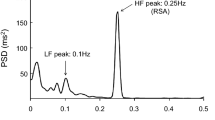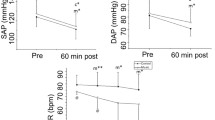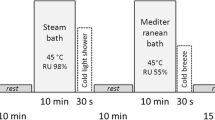Abstract
Objective
Daily sessions of slow-breathing (6 breaths/min) significantly reduced 24-h ambulatory blood pressure (ABP) in patients with mild hypertension and this effect persisted at least 6 months after the interruption of sessions. The sequence of changes induced by slow-breathing (SB) daily sessions on the modulation of ambulatory blood pressure, renal resistive index, heart rate variability (HRV), and baroreflex sensitivity (BRS) was thus investigated in a randomized, controlled clinical trial.
Methods
Thirty-seven patients (30–75 years, grade I essential hypertension), untreated with antihypertensive drugs, were randomized to daily sessions (30 min) of music-guided SB (<10 breaths/min) (intervention, n = 24) or simple relaxation (control, n = 13). Office and ambulatory blood pressure monitoring renal Doppler ultrasound, assessment of BRS (sequence method and spectral analysis), and HRV (spectral power in the high- and low-frequency bands) were performed at baseline, and after 1, 4, and 8 weeks. Mixed model analysis was conducted on derived variables given by the difference between each measurement and the baseline value within subjects.
Results
After 1 week, the intervention enhanced the parasympathetic modulation (high-frequency power; at least p < 0.05 vs both control and baseline) and reduced renal vascular resistance (p < 0.05 for both comparisons); after 1 month, the enhancement of BRS (p < 0.05 for both comparisons at both methods) paralleled a significant reduction in 24 h ABP (p < 0.05 for all comparisons).
Interpretation
Repeated daily session of music-guided SB increased parasympathetic modulation and decreased renal resistive index early in the study. These changes were being followed by a positive modulation of BRS and blood pressure reduction.

Similar content being viewed by others
References
Pal GK, Adithan C, Ananthanarayanan PH, Pal P, Nanda N, Thiyagarajan D, Syamsunderkiran AN, Lalitha V, Dutta TK (2013) Association of sympathovagal imbalance with cardiovascular risks in young prehypertensives. Am J Cardiol 112(11):1757–1762
Gallagher D, Terenzi T, de Meersman R (1992) Heart rate variability in smokers, sedentary and aerobically fit individuals. Clin Auton Res 2(6):383–387
Joseph CN, Porta C, Casucci G, Casiraghi N, Maffeis M, Rossi M, Bernardi L (2005) Slow breathing improves arterial baroreflex sensitivity and decreases blood pressure in essential hypertension. Hypertension 46(4):714–718
Bernardi L, Porta C, Spicuzza L, Bellwon J, Spadacini G, Frey AW, Yeung LY, Sanderson JE, Pedretti R, Tramarin R (2002) Slow breathing increases arterial baroreflex sensitivity in patients with chronic heart failure. Circulation 105(2):143–145
Bernardi L, Gabutti A, Porta C, Spicuzza L (2001) Slow breathing reduces chemoreflex response to hypoxia and hypercapnia, and increases baroreflex sensitivity. J Hypertens 19(12):2221–2229
Spicuzza L, Gabutti A, Porta C, Montano N, Bernardi L (2000) Yoga and chemoreflex response to hypoxia and hypercapnia. Lancet 356(9240):1495–1496
Rosenthal T, Alter A, Peleg E, Gavish B (2001) Device-guided breathing exercises reduce blood pressure: ambulatory and home measurements. Am J Hypertens 14(1):74–76
Grossman E, Grossman A, Schein MH, Zimlichman R, Gavish B (2001) Breathing-control lowers blood pressure. J Hum Hypertens 15(4):263–269
Schein MH, Gavish B, Herz M, Rosner-Kahana D, Naveh P, Knishkowy B, Zlotnikov E, Ben-Zvi N, Melmed RN (2001) Treating hypertension with a device that slows and regularises breathing: a randomised, double-blind controlled study. J Hum Hypertens 15(4):271–278
Viskoper R, Shapira I, Priluck R, Mindlin R, Chornia L, Laszt A, Dicker D, Gavish B, Alter A (2003) Nonpharmacologic treatment of resistant hypertensives by device-guided slow breathing exercises. Am J Hypertens 16(6):484–487
Meles E, Giannattasio C, Failla M, Gentile G, Capra A, Mancia G (2004) Nonpharmacologic treatment of hypertension by respiratory exercise in the home setting. Am J Hypertens 17(4):370–374
Elliot WJ, Izzo JL Jr, White WB, Rosing DR, Snyder CS, Alter A, Gavish B, Black HR (2004) Graded blood pressure reduction in hypertensive outpatients associated with use of a device to assist with slow breathing. J Clin Hypertens (Greenwich) 6(10):553–559
Modesti PA, Ferrari A, Bazzini C, Costanzo G, Simonetti I, Taddei S, Biggeri A, Parati G, Gensini GF, Sirigatti S (2010) Psychological predictors of the antihypertensive effects of music-guided slow breathing. J Hypertens 28(5):1097–1103
Brook RD, Appel LJ, Rubenfire M, Ogedegbe G, Bisognano JD, Elliott WJ, Fuchs FD, Hughes JW, Lackland DT, Staffileno BA, Townsend RR, Rajagopalan S, American Heart Association Professional Education Committee of the Council for High Blood Pressure Research CoC, Stroke Nursing CoE, Prevention, Council on Nutrition PA (2013) Beyond medications and diet: alternative approaches to lowering blood pressure: a scientific statement from the american heart association. Hypertension 61(6):1360–1383
Limberg JK, Morgan BJ, Schrage WG, Dempsey JA (2013) Respiratory influences on muscle sympathetic nerve activity and vascular conductance in the steady state. Am J Physiol Heart Circ Physiol 304(12):H1615–H1623
Mancia G, Fagard R, Narkiewicz K, Redon J, Zanchetti A, Bohm M, Christiaens T, Cifkova R, De Backer G, Dominiczak A, Galderisi M, Grobbee DE, Jaarsma T, Kirchhof P, Kjeldsen SE, Laurent S, Manolis AJ, Nilsson PM, Ruilope LM, Schmieder RE, Sirnes PA, Sleight P, Viigimaa M, Waeber B, Zannad F (2013) 2013 ESH/ESC Guidelines for the management of arterial hypertension The Task Force for the management of arterial hypertension of the European Society of Hypertension (ESH) and of the European Society of Cardiology (ESC). J Hypertens 31(7):1281–1357
Boddi M, Sacchi S, Lammel RM, Mohseni R, Serneri GG (1996) Age-related and vasomotor stimuli-induced changes in renal vascular resistance detected by Doppler ultrasound. Am J Hypertens 9(5):461–466
Parati G, Di Rienzo M, Bertinieri G, Pomidossi G, Casadei R, Groppelli A, Pedotti A, Zanchetti A, Mancia G (1988) Evaluation of the baroreceptor-heart rate reflex by 24-hour intra-arterial blood pressure monitoring in humans. Hypertension 12(2):214–222
Pagani M, Somers V, Furlan R, Dell’Orto S, Conway J, Baselli G, Cerutti S, Sleight P, Malliani A (1988) Changes in autonomic regulation induced by physical training in mild hypertension. Hypertension 12(6):600–610
Camm AJ, Malik M, Bigger JT, Breithardt G, Cerutti S, Cohen RJ, Coumel P, Fallen EL, Kennedy HL, Kleiger RE, Lombardi F, Malliani A, Moss AJ, Rottman JN, Schmidt G, Schwartz PJ, Singer DH (1996) Heart rate variability. Standards of measurement, physiological interpretation, and clinical use. Eur Heart J 17(3):354–381
Malliani A, Pagani M, Lombardi F, Cerutti S (1991) Cardiovascular neural regulation explored in the frequency domain. Circulation 84(2):482–492
Mori H, Yamamoto H, Kuwashima M, Saito S, Ukai H, Hirao K, Yamauchi M, Umemura S (2005) How does deep breathing affect office blood pressure and pulse rate? Hypertens Res 28(6):499–504
(2007) Resperate for hypertension. Med Lett Drugs Ther 49(1264):55–56
Mahtani KR, Nunan D, Heneghan CJ (2012) Device-guided breathing exercises in the control of human blood pressure: systematic review and meta-analysis. J Hypertens 30(5):852–860
Howorka K, Pumprla J, Tamm J, Schabmann A, Klomfar S, Kostineak E, Howorka N, Sovova E (2013) Effects of guided breathing on blood pressure and heart rate variability in hypertensive diabetic patients. Auton Neurosci 179(1–2):131–137
Anderson DE, McNeely JD, Windham BG (2010) Regular slow-breathing exercise effects on blood pressure and breathing patterns at rest. J Hum Hypertens 24(12):807–813
Hering D, Kucharska W, Kara T, Somers VK, Parati G, Narkiewicz K (2013) Effects of acute and long-term slow breathing exercise on muscle sympathetic nerve activity in untreated male patients with hypertension. J Hypertens 31(4):739–746
Laterza MC, de Matos LD, Trombetta IC, Braga AM, Roveda F, Alves MJ, Krieger EM, Negrao CE, Rondon MU (2007) Exercise training restores baroreflex sensitivity in never-treated hypertensive patients. Hypertension 49(6):1298–1306
Cozza IC, Di Sacco THR, Mazon JH, Salgado MCO, Dutra SGV, Cesarino EJ, Souza HCD (2012) Physical exercise improves cardiac autonomic modulation in hypertensive patients independently of angiotensin-converting enzyme inhibitor treatment. Hypertens Res 35(1):82–87
Wang J, Xiong X, Liu W (2013) Yoga for essential hypertension: a systematic review. PLoS ONE 8(10):e76357
Somers VK, Conway J, Johnston J, Sleight P (1991) Effects of endurance training on baroreflex sensitivity and blood-pressure in borderline hypertension. Lancet 337(8754):1363–1368
Sandercock GRH, Bromley PD, Brodie DA (2005) Effects of exercise on heart rate variability: inferences from meta-analysis. Med Sci Sports Exerc 37(3):433–439
Miki K, Hayashida Y, Shiraki K (1993) Cardiac-renal-neural reflex plays a major role in natriuresis induced by left atrial distension. Am J Physiol 264(2 Pt 2):R369–R375
Majid DS, Karim F (1995) Primary neural involvement in renal haemodynamic and functional responses to prolonged stimulation of atrial receptors in anaesthetized dogs. Exp Physiol 80(4):631–644
Fater DC, Schultz HD, Sundet WD, Mapes JS, Goetz KL (1982) Effects of left atrial stretch in cardiac-denervated and intact conscious dogs. Am J Physiol 242(6):H1056–H1064
Santaella DF, Devesa CR, Rojo MR, Amato MB, Drager LF, Casali KR, Montano N, Lorenzi-Filho G (2011) Yoga respiratory training improves respiratory function and cardiac sympathovagal balance in elderly subjects: a randomised controlled trial. BMJ Open 1(1):e000085
Acknowledgments
This study was supported by a grant from the University of Florence (progetti di ricerca d’ateneo ex 60 % 2010/2011), and Regione Toscana (PMI 2009 POR CReO FESR 2007–2013-linea d’intervento 1.1.c, D.D. n. 1942 del 10.04.2009).
Conflict of interest
On behalf of all authors, the corresponding author states that there is no conflict of interest.
Author information
Authors and Affiliations
Corresponding author
Rights and permissions
About this article
Cite this article
Modesti, P.A., Ferrari, A., Bazzini, C. et al. Time sequence of autonomic changes induced by daily slow-breathing sessions. Clin Auton Res 25, 95–104 (2015). https://doi.org/10.1007/s10286-014-0255-9
Received:
Accepted:
Published:
Issue Date:
DOI: https://doi.org/10.1007/s10286-014-0255-9




